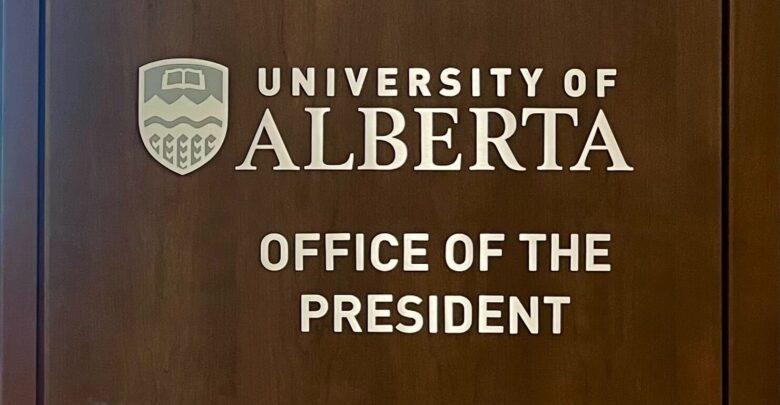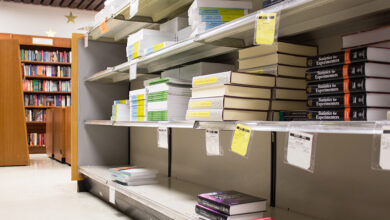 Leah Hennig
Leah HennigUniversity of Alberta administration is about to learn how difficult it is to rebuild its relationship and trust with students — and it needs to learn quickly.
U of A’s communication about the Palestine solidarity encampment and its dispersal by the Edmonton Police Service (EPS) has eroded the trust of students and faculty. Administration has told students that it’s prioritizing student safety and freedom of expression, while simultaneously acting against those things. Students and faculty have seen the contradictions and rightly feel like they can’t trust administration anymore.
The statements released by President and Vice-chancellor Bill Flanagan haven’t matched up with what people are seeing and hearing from protesters. It’s not just personal testimonies that contradict what Flanagan has said — it’s also video evidence.
Administrators and Flanagan need to start being honest and transparent with students, and apologize for not doing so from the beginning. This needs to happen before the relationship of trust with students and faculty breaks beyond repair.
With students and faculty calling for the resignation of Flanagan and other administrators, it may already be too late. But, even if they resign, they will not take the damaged relationship with them. It will remain for future and present administrators to piece back together again.
Following the beginning of the encampment on May 9, Flanagan released a statement. Initially, the statement seemed like a mild response, especially in contrast to the University of Calgary’s decision to have police clear an encampment the day it began. Flanagan affirmed the U of A’s commitment to freedom of expression and safety of students.
Yet, U of A Protective Services (UAPS) gave the encampment the first of several trespass notices only an hour after the statement was released. The trespass notice threatened fines, criminal charges, imprisonment, and academic sanctions for students and faculty who remained at the encampment. These notices did nothing to facilitate freedom of expression, and rather only attempted to intimidate protesters.
After two days, EPS cleared the encampment, per the university’s request. This did not uphold a commitment to freedom of expression, despite Flanagan’s statement. Nor did it ensure the safety of students and faculty, which Flanagan said was a “primary concern.”
Videos of EPS dismantling the encampment show the incredible amount of force EPS used. Police officers pushed protesters to the ground, hit them with batons, and used OC powder and pepper bullets. EPS left one protester’s leg bleeding and another reportedly had to be taken to the hospital.
The university said it made this decision in the name of student safety. It’s apparent to me that none of the actions taken by EPS, per the university’s request for their assistance, were safe. With the mounting evidence and testimonies, administration and Flanagan can’t claim ignorance about the impact of his decision.
Flanagan said in a second statement on May 11 that only 25 per cent of protesters were U of A students. He doesn’t say how he arrived at this percentage, so for all we know he pulled it out of a hat. But regardless of how many, there were students present at the encampment that witnessed — if not directly experienced — violence from EPS.
Despite its repeated commitment to student safety, the university has not taken any responsibility for how it dealt with the encampment. Rather, the university said the encampment was “peacefully dispersed.” Anyone who has seen the videos from that morning knows that isn’t true. The U of A’s actions and their words aren’t matching up.
The lack of transparency only continued. On May 11, Frank Page, UAPS threat assessment program and investigations manager, told protesters they were “officially banned for a period of a year from U of A campuses.” There is a clear video of Page telling the encampment this. Yet, the university disputed the “misinformation being shared” and said no students from the encampment had been banned.
The university completely failed to acknowledge that it was a UAPS officer who spread the “misinformation.” If the university can’t even acknowledge the mistakes of one officer, it will have a hard time acknowledging the mistakes of administrators.
The May 11 statement also said there were “escalating acts” that were the reason for clearing the encampment. But it is completely unclear what those acts were. I was on campus to observe the encampment from around 10:30 p.m. to 11:40 p.m. on May 10. There were no signs of “escalating acts,” only anxiety over the threat of EPS clearing the encampment.
Flanagan clarified some safety concerns in his May 12 statement, but it still doesn’t add up. He said that the presence of pallets was a fire hazard and that the university had told the encampment to remove them. However, in their statement, the Peoples University for Palestine YEG said they complied and put the pallets in nearby dumpsters. But that wasn’t good enough for the U of A. Anything within 150 metres of the encampment is apparently the encampment’s responsibility.
Flanagan’s statement also specified that EPS found “potential weapons” after the encampment was dismantled. But the university had no way of knowing this beforehand. Trying to retroactively justify clearing the encampment doesn’t explain the university’s initial decision. The university has repeatedly failed to fairly portray the encampment.
Once again, Flanagan reiterated the university’s responsibility for the safety on campus but he failed to acknowledge the harm done by calling EPS in. Flanagan stood behind the unsafe and violent actions of EPS — actions that caused tangible harm.
Flanagan called EPS’ actions the “only reasonable measure … to end the encampment as peacefully and respectfully as possible.” Yet the protesters have repeatedly said that the university made no effort to communicate with them beyond the notices. Instead of engaging in productive dialogue, administration quickly allowed the violent dismantling of the encampment. But, once again, there’s no acknowledgement of its failures to come to a non-violent resolution, or to even try to.
In the days following the dispersal, it’s become clear that the protests and demands aren’t going away. Rallies and protests have taken place on campus, and the frustration has only grown. The U of A not only put students in danger and misled them, but completely failed to resolve anything.
Several student groups have released statements regarding the encampment. Statements from the Graduate Students’ Association (GSA), Indigenous Students’ Union (ISU), International Students’ Association, U of A Students’ Union (UASU), and other student groups affirmed students’ right to freedom of speech and expression. After the encampment was cleared, several student groups released statements condemning the use of force by EPS against protesters.
Students have also it made clear on social media that majority of the U of A’s statements are completely inaccurate and misleading. It’s not a small amount of students that the U of A is going to need to repair relationships with. It’s a huge portion of the student body and the groups that represent them.
Administration hasn’t only damaged its relationship with students, but with faculty too. The Association of Academic Staff University of Alberta (AASUA) and the Non-Academic Staff Association (NASA) co-signed a letter to Flanagan with the UASU and GSA. Faculty were among those threatened by the notices, misled by Flanagan’s statements, and frustrated with the response to the encampment. Faculty for Palestine Alberta, a province-wide organization, started a petition calling for Flanagan to resign. It won’t be easy for the university to rebuild these relationships, especially without taking accountability.
Flanagan met with the AASU, GSA, NASA, and the UASU, and released yet another statement on May 14. He only reiterated what he had said before, seeming to not have taken anything away from that meeting. Flanagan said he would be meeting with other community partners and providing regular updates. But these updates aren’t solving anything — nor has he taken any real responsibility in these statements.
On May 14, Natalie Loveless, a professor in the department of art and design and former faculty of arts associate dean (equity, diversity, and inclusion) (EDI), resigned from her associate dean position. In a letter sent to her colleagues, she made it clear that the university’s actions and words led to her resignation. In the following days, all members of the Faculty of Arts Committee on EDI (CEDI) resigned, according to the People’s University For Palestine. Through their actions, Flanagan and administration have pushed away and harmed the administrators who genuinely care about students.
The university’s failure to take care of students and faculty and be honest with them is no small thing. People resigning from a university EDI committee should be a wake-up call to administration — if nothing else already has been.
But rebuilding that trust and those relationships can’t start until the U of A takes responsibility for its decisions. There is no excuse or justification for misleading students. The U of A needs to do this now — otherwise, there is no way forward.




